Leadership Management: Concept Report on KPI Utility & Challenges
VerifiedAdded on 2020/03/15
|7
|1396
|100
Report
AI Summary
This report delves into the critical role of Key Performance Indicators (KPIs) in project management, emphasizing their utility, challenges, and measurement techniques. It begins by defining KPIs as measurable values that gauge an organization's efficiency in achieving objectives and highlights their connection to strategic goals. The report explores the selection process of KPIs, stressing the importance of aligning them with project goals and answering key questions to ensure their relevance and measurability. It then examines KPI measurement and appraisal methods, providing examples like cost variance analysis and earned value analysis. The report also discusses the challenges project managers face, such as data collection from diverse sources and ensuring consistency in measurement. Finally, it offers recommendations for improving data collection through integrative systems, consistent measurement methods, and appropriate tools. The report also suggests communication strategies to keep stakeholders informed and engaged in the KPI development and reporting process.
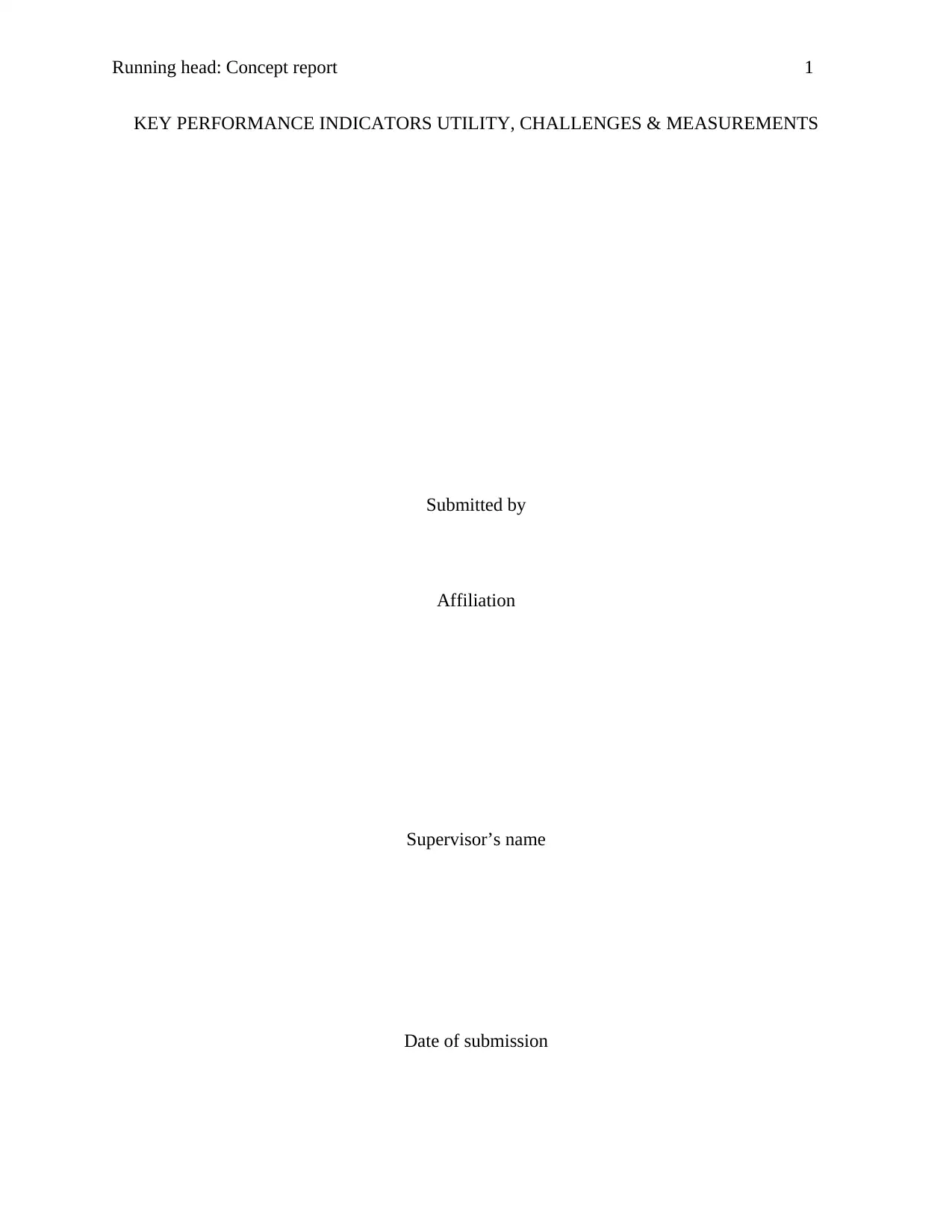
Running head: Concept report 1
KEY PERFORMANCE INDICATORS UTILITY, CHALLENGES & MEASUREMENTS
Submitted by
Affiliation
Supervisor’s name
Date of submission
KEY PERFORMANCE INDICATORS UTILITY, CHALLENGES & MEASUREMENTS
Submitted by
Affiliation
Supervisor’s name
Date of submission
Paraphrase This Document
Need a fresh take? Get an instant paraphrase of this document with our AI Paraphraser

Running head: Concept report 2
1.0.Introduction
Key performance indicators (KPI) are defined as measurable values representing how efficient
an organization is able to achieve its main objectives (Chambers, 2013). KPI is used by projects
to analysis its level of functions to identify if the targets are achieved. The analysis can be done
using either high level or low level KPI’s. In strategic planning and management KPI’s are
linked with organization goals, vision and strategies to clearly define what is going to be
achieved in both long-run and short-run planning (Parmenter & ProQuest, 2012).
1.1. Selection of KPI’s in project implementation
Selection of KPI’s in projects is based on whether they are directly matching with project goals
and whether the management has clear goals to be achieved. Suitable KPI’s are selected based on
the goals set by the projects and should be directly linked to them. Identification and definition
of KPI’s will follow a series of questions to be answered. The questions include: What does the
project expect in terms of results? Do the results from the project matter? How will results be
measured? Can the results be influenced? Who will be responsible to the results? And how will
the results monitored and measured? Provision of answers to the question will lead to a KPI
which is SMART. Eventually development and choice of a KPI will be based on whether they
are specific, measurable, and achievable, result oriented and can be completed on time.
KPI can by project management in different phases of the project life cycle. During
implementation stage a lion share of activities take place. It is in the implementation phase that
managers are keen on ensuring activities, functions and processes are in line with planned
standards and specifications. The work of project managers is to ensure costs and quality is
maintained at this phase. In project implementation one can choose KPI’s that are useful in
1.0.Introduction
Key performance indicators (KPI) are defined as measurable values representing how efficient
an organization is able to achieve its main objectives (Chambers, 2013). KPI is used by projects
to analysis its level of functions to identify if the targets are achieved. The analysis can be done
using either high level or low level KPI’s. In strategic planning and management KPI’s are
linked with organization goals, vision and strategies to clearly define what is going to be
achieved in both long-run and short-run planning (Parmenter & ProQuest, 2012).
1.1. Selection of KPI’s in project implementation
Selection of KPI’s in projects is based on whether they are directly matching with project goals
and whether the management has clear goals to be achieved. Suitable KPI’s are selected based on
the goals set by the projects and should be directly linked to them. Identification and definition
of KPI’s will follow a series of questions to be answered. The questions include: What does the
project expect in terms of results? Do the results from the project matter? How will results be
measured? Can the results be influenced? Who will be responsible to the results? And how will
the results monitored and measured? Provision of answers to the question will lead to a KPI
which is SMART. Eventually development and choice of a KPI will be based on whether they
are specific, measurable, and achievable, result oriented and can be completed on time.
KPI can by project management in different phases of the project life cycle. During
implementation stage a lion share of activities take place. It is in the implementation phase that
managers are keen on ensuring activities, functions and processes are in line with planned
standards and specifications. The work of project managers is to ensure costs and quality is
maintained at this phase. In project implementation one can choose KPI’s that are useful in
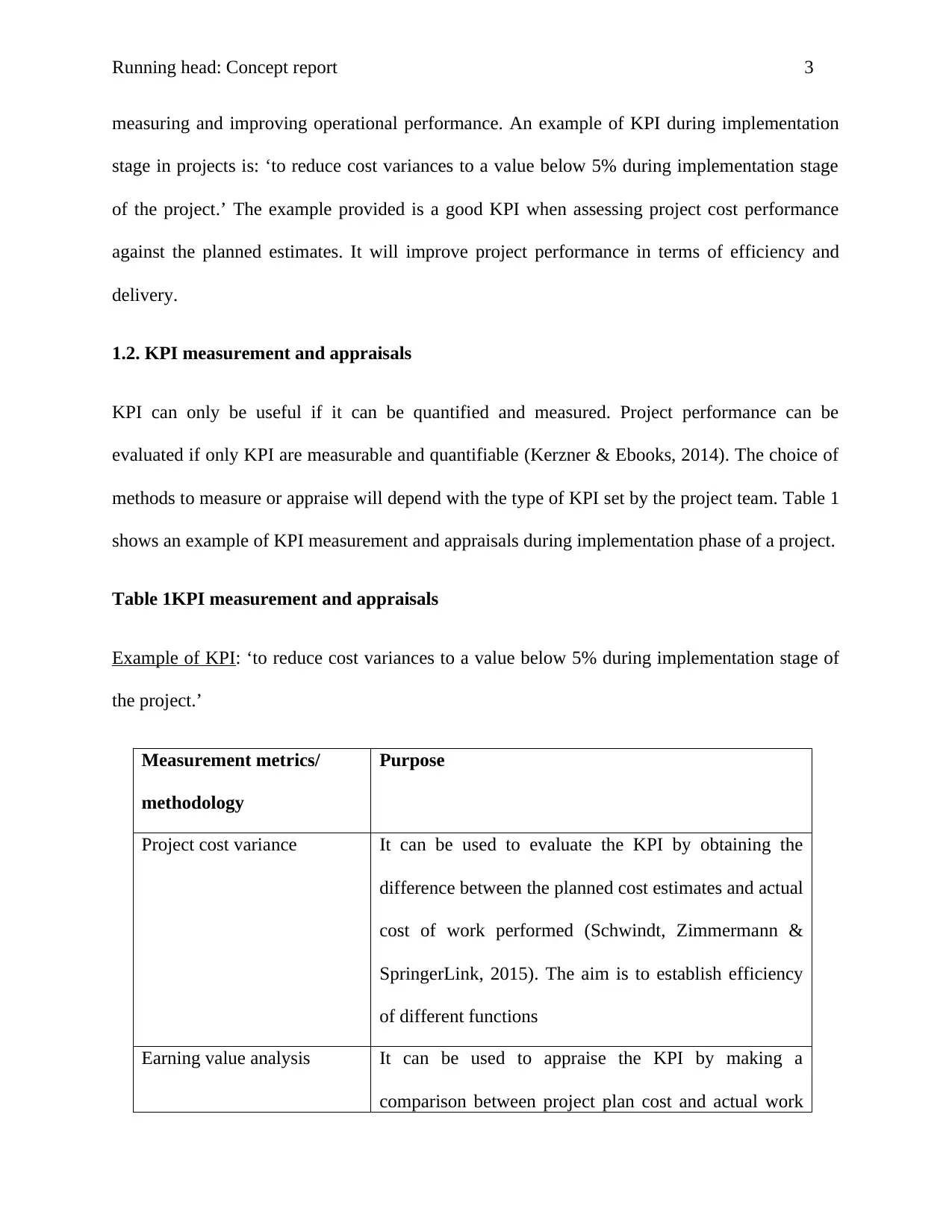
Running head: Concept report 3
measuring and improving operational performance. An example of KPI during implementation
stage in projects is: ‘to reduce cost variances to a value below 5% during implementation stage
of the project.’ The example provided is a good KPI when assessing project cost performance
against the planned estimates. It will improve project performance in terms of efficiency and
delivery.
1.2. KPI measurement and appraisals
KPI can only be useful if it can be quantified and measured. Project performance can be
evaluated if only KPI are measurable and quantifiable (Kerzner & Ebooks, 2014). The choice of
methods to measure or appraise will depend with the type of KPI set by the project team. Table 1
shows an example of KPI measurement and appraisals during implementation phase of a project.
Table 1KPI measurement and appraisals
Example of KPI: ‘to reduce cost variances to a value below 5% during implementation stage of
the project.’
Measurement metrics/
methodology
Purpose
Project cost variance It can be used to evaluate the KPI by obtaining the
difference between the planned cost estimates and actual
cost of work performed (Schwindt, Zimmermann &
SpringerLink, 2015). The aim is to establish efficiency
of different functions
Earning value analysis It can be used to appraise the KPI by making a
comparison between project plan cost and actual work
measuring and improving operational performance. An example of KPI during implementation
stage in projects is: ‘to reduce cost variances to a value below 5% during implementation stage
of the project.’ The example provided is a good KPI when assessing project cost performance
against the planned estimates. It will improve project performance in terms of efficiency and
delivery.
1.2. KPI measurement and appraisals
KPI can only be useful if it can be quantified and measured. Project performance can be
evaluated if only KPI are measurable and quantifiable (Kerzner & Ebooks, 2014). The choice of
methods to measure or appraise will depend with the type of KPI set by the project team. Table 1
shows an example of KPI measurement and appraisals during implementation phase of a project.
Table 1KPI measurement and appraisals
Example of KPI: ‘to reduce cost variances to a value below 5% during implementation stage of
the project.’
Measurement metrics/
methodology
Purpose
Project cost variance It can be used to evaluate the KPI by obtaining the
difference between the planned cost estimates and actual
cost of work performed (Schwindt, Zimmermann &
SpringerLink, 2015). The aim is to establish efficiency
of different functions
Earning value analysis It can be used to appraise the KPI by making a
comparison between project plan cost and actual work
⊘ This is a preview!⊘
Do you want full access?
Subscribe today to unlock all pages.

Trusted by 1+ million students worldwide
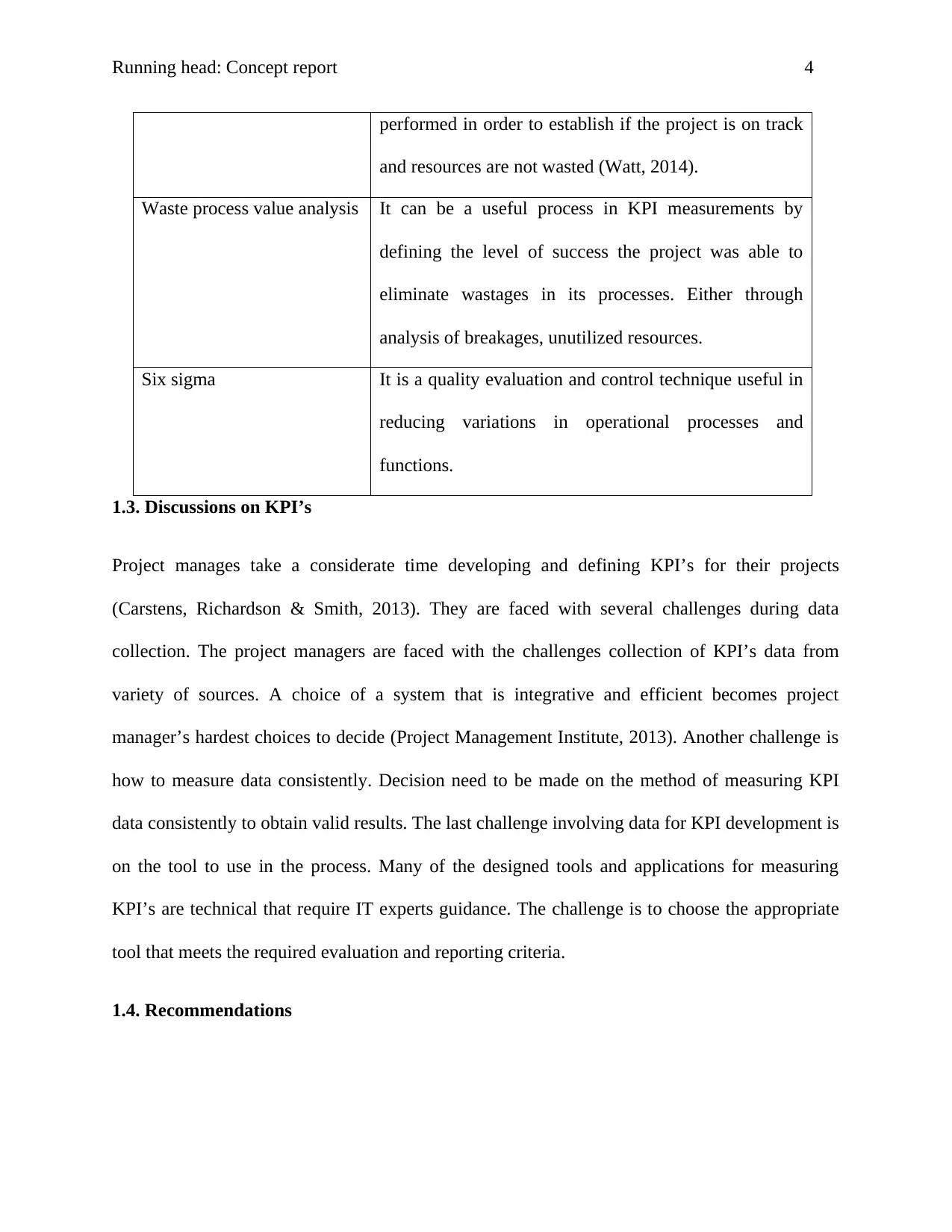
Running head: Concept report 4
performed in order to establish if the project is on track
and resources are not wasted (Watt, 2014).
Waste process value analysis It can be a useful process in KPI measurements by
defining the level of success the project was able to
eliminate wastages in its processes. Either through
analysis of breakages, unutilized resources.
Six sigma It is a quality evaluation and control technique useful in
reducing variations in operational processes and
functions.
1.3. Discussions on KPI’s
Project manages take a considerate time developing and defining KPI’s for their projects
(Carstens, Richardson & Smith, 2013). They are faced with several challenges during data
collection. The project managers are faced with the challenges collection of KPI’s data from
variety of sources. A choice of a system that is integrative and efficient becomes project
manager’s hardest choices to decide (Project Management Institute, 2013). Another challenge is
how to measure data consistently. Decision need to be made on the method of measuring KPI
data consistently to obtain valid results. The last challenge involving data for KPI development is
on the tool to use in the process. Many of the designed tools and applications for measuring
KPI’s are technical that require IT experts guidance. The challenge is to choose the appropriate
tool that meets the required evaluation and reporting criteria.
1.4. Recommendations
performed in order to establish if the project is on track
and resources are not wasted (Watt, 2014).
Waste process value analysis It can be a useful process in KPI measurements by
defining the level of success the project was able to
eliminate wastages in its processes. Either through
analysis of breakages, unutilized resources.
Six sigma It is a quality evaluation and control technique useful in
reducing variations in operational processes and
functions.
1.3. Discussions on KPI’s
Project manages take a considerate time developing and defining KPI’s for their projects
(Carstens, Richardson & Smith, 2013). They are faced with several challenges during data
collection. The project managers are faced with the challenges collection of KPI’s data from
variety of sources. A choice of a system that is integrative and efficient becomes project
manager’s hardest choices to decide (Project Management Institute, 2013). Another challenge is
how to measure data consistently. Decision need to be made on the method of measuring KPI
data consistently to obtain valid results. The last challenge involving data for KPI development is
on the tool to use in the process. Many of the designed tools and applications for measuring
KPI’s are technical that require IT experts guidance. The challenge is to choose the appropriate
tool that meets the required evaluation and reporting criteria.
1.4. Recommendations
Paraphrase This Document
Need a fresh take? Get an instant paraphrase of this document with our AI Paraphraser
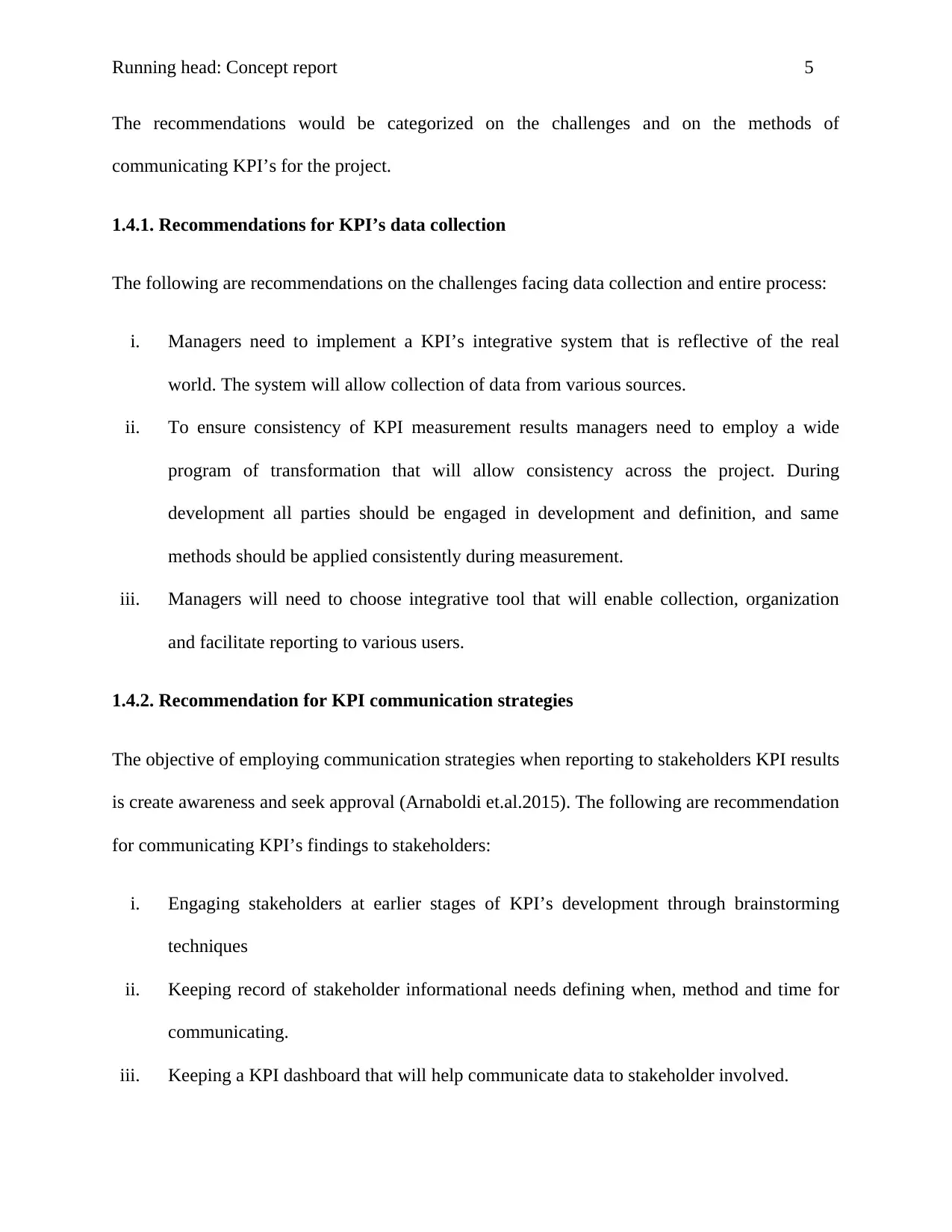
Running head: Concept report 5
The recommendations would be categorized on the challenges and on the methods of
communicating KPI’s for the project.
1.4.1. Recommendations for KPI’s data collection
The following are recommendations on the challenges facing data collection and entire process:
i. Managers need to implement a KPI’s integrative system that is reflective of the real
world. The system will allow collection of data from various sources.
ii. To ensure consistency of KPI measurement results managers need to employ a wide
program of transformation that will allow consistency across the project. During
development all parties should be engaged in development and definition, and same
methods should be applied consistently during measurement.
iii. Managers will need to choose integrative tool that will enable collection, organization
and facilitate reporting to various users.
1.4.2. Recommendation for KPI communication strategies
The objective of employing communication strategies when reporting to stakeholders KPI results
is create awareness and seek approval (Arnaboldi et.al.2015). The following are recommendation
for communicating KPI’s findings to stakeholders:
i. Engaging stakeholders at earlier stages of KPI’s development through brainstorming
techniques
ii. Keeping record of stakeholder informational needs defining when, method and time for
communicating.
iii. Keeping a KPI dashboard that will help communicate data to stakeholder involved.
The recommendations would be categorized on the challenges and on the methods of
communicating KPI’s for the project.
1.4.1. Recommendations for KPI’s data collection
The following are recommendations on the challenges facing data collection and entire process:
i. Managers need to implement a KPI’s integrative system that is reflective of the real
world. The system will allow collection of data from various sources.
ii. To ensure consistency of KPI measurement results managers need to employ a wide
program of transformation that will allow consistency across the project. During
development all parties should be engaged in development and definition, and same
methods should be applied consistently during measurement.
iii. Managers will need to choose integrative tool that will enable collection, organization
and facilitate reporting to various users.
1.4.2. Recommendation for KPI communication strategies
The objective of employing communication strategies when reporting to stakeholders KPI results
is create awareness and seek approval (Arnaboldi et.al.2015). The following are recommendation
for communicating KPI’s findings to stakeholders:
i. Engaging stakeholders at earlier stages of KPI’s development through brainstorming
techniques
ii. Keeping record of stakeholder informational needs defining when, method and time for
communicating.
iii. Keeping a KPI dashboard that will help communicate data to stakeholder involved.
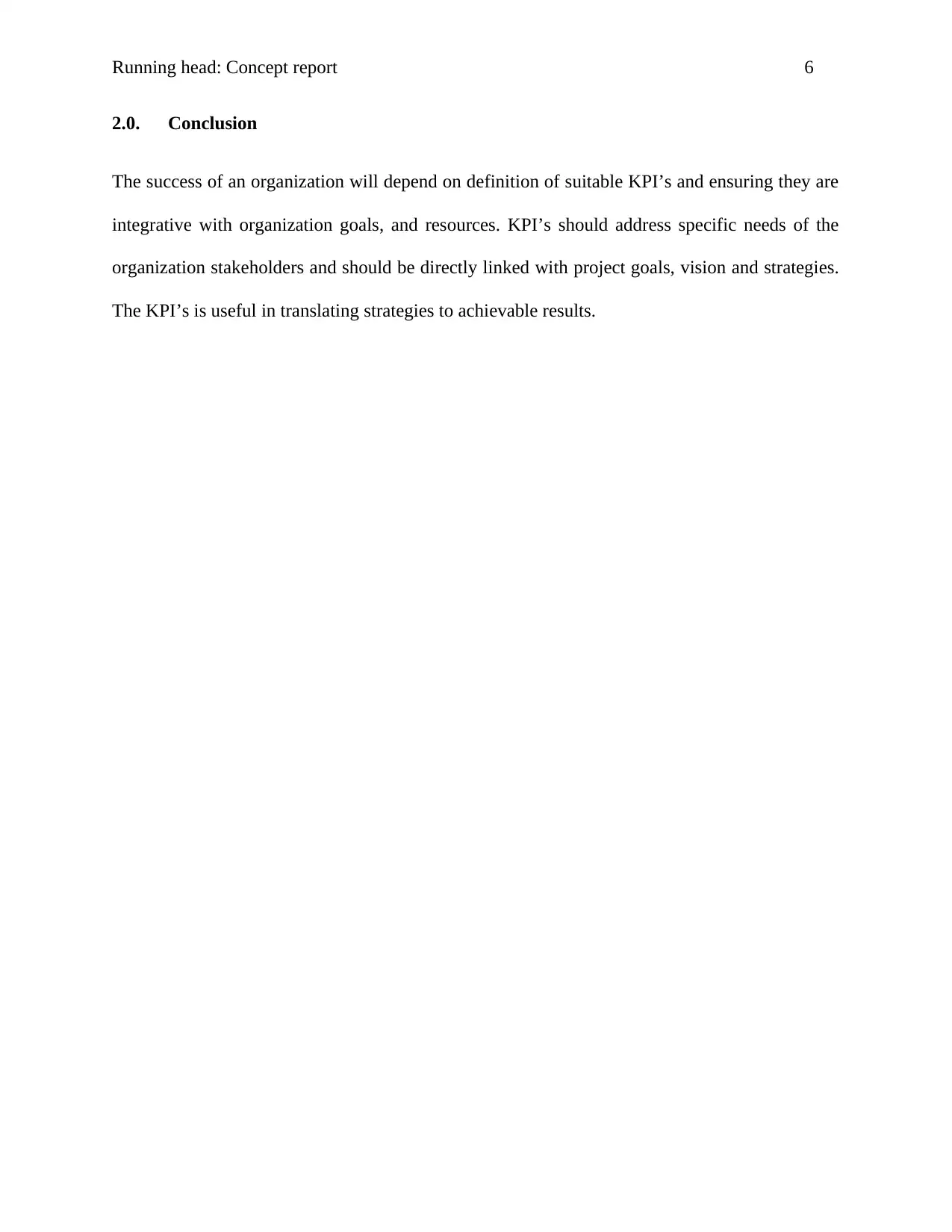
Running head: Concept report 6
2.0. Conclusion
The success of an organization will depend on definition of suitable KPI’s and ensuring they are
integrative with organization goals, and resources. KPI’s should address specific needs of the
organization stakeholders and should be directly linked with project goals, vision and strategies.
The KPI’s is useful in translating strategies to achievable results.
2.0. Conclusion
The success of an organization will depend on definition of suitable KPI’s and ensuring they are
integrative with organization goals, and resources. KPI’s should address specific needs of the
organization stakeholders and should be directly linked with project goals, vision and strategies.
The KPI’s is useful in translating strategies to achievable results.
⊘ This is a preview!⊘
Do you want full access?
Subscribe today to unlock all pages.

Trusted by 1+ million students worldwide

Running head: Concept report 7
References
Arnaboldi, A., Giorgino, A., Giovanni, Giorgino, M., & Ebooks C, (2015). Performance
measurement and management for engineers (Elsevier Science Direct E-books).
Carstens, D., Richardson, G., & Smith, R. (2013). Project management tools and techniques : A
practical guide.
Chambers, D. (2013). Key performance indicators. The Journal of the American Dental
Association, 144(3), 242-244.
Kerzner, H., & Ebooks Corporation. (2014). Project management best practices achieving global
excellence (3rd ed., Ebook Library (EBL)). Hoboken: Wiley.
Parmenter, D., & ProQuest. (2012). Key performance indicators for government and non-profit
agencies implementing winning KPIs. Hoboken, N.J.: John Wiley & Sons.
Project Management Institute. (2013). A guide to the project management body of knowledge
(PMBOK guide). (Fifth ed.).
Schwindt, C., Zimmermann, J., & SpringerLink. (2015). Handbook on project management and
scheduling. Vol. 1 (International handbooks on information systems).
Watt, A., B. (2014). Project Management, John Wiley & Sons.
References
Arnaboldi, A., Giorgino, A., Giovanni, Giorgino, M., & Ebooks C, (2015). Performance
measurement and management for engineers (Elsevier Science Direct E-books).
Carstens, D., Richardson, G., & Smith, R. (2013). Project management tools and techniques : A
practical guide.
Chambers, D. (2013). Key performance indicators. The Journal of the American Dental
Association, 144(3), 242-244.
Kerzner, H., & Ebooks Corporation. (2014). Project management best practices achieving global
excellence (3rd ed., Ebook Library (EBL)). Hoboken: Wiley.
Parmenter, D., & ProQuest. (2012). Key performance indicators for government and non-profit
agencies implementing winning KPIs. Hoboken, N.J.: John Wiley & Sons.
Project Management Institute. (2013). A guide to the project management body of knowledge
(PMBOK guide). (Fifth ed.).
Schwindt, C., Zimmermann, J., & SpringerLink. (2015). Handbook on project management and
scheduling. Vol. 1 (International handbooks on information systems).
Watt, A., B. (2014). Project Management, John Wiley & Sons.
1 out of 7
Related Documents
Your All-in-One AI-Powered Toolkit for Academic Success.
+13062052269
info@desklib.com
Available 24*7 on WhatsApp / Email
![[object Object]](/_next/static/media/star-bottom.7253800d.svg)
Unlock your academic potential
Copyright © 2020–2025 A2Z Services. All Rights Reserved. Developed and managed by ZUCOL.




